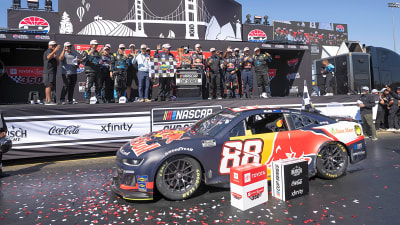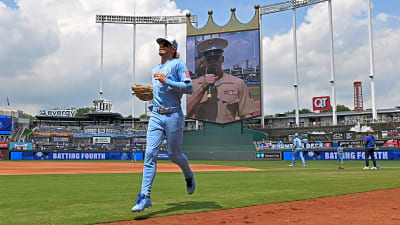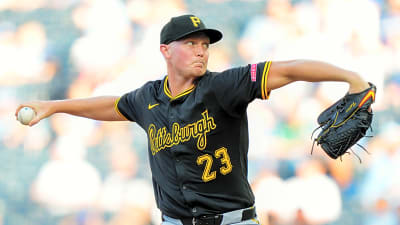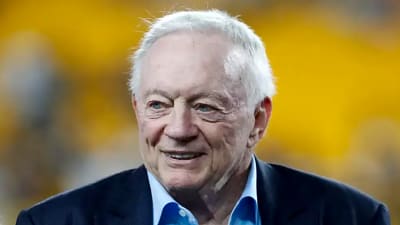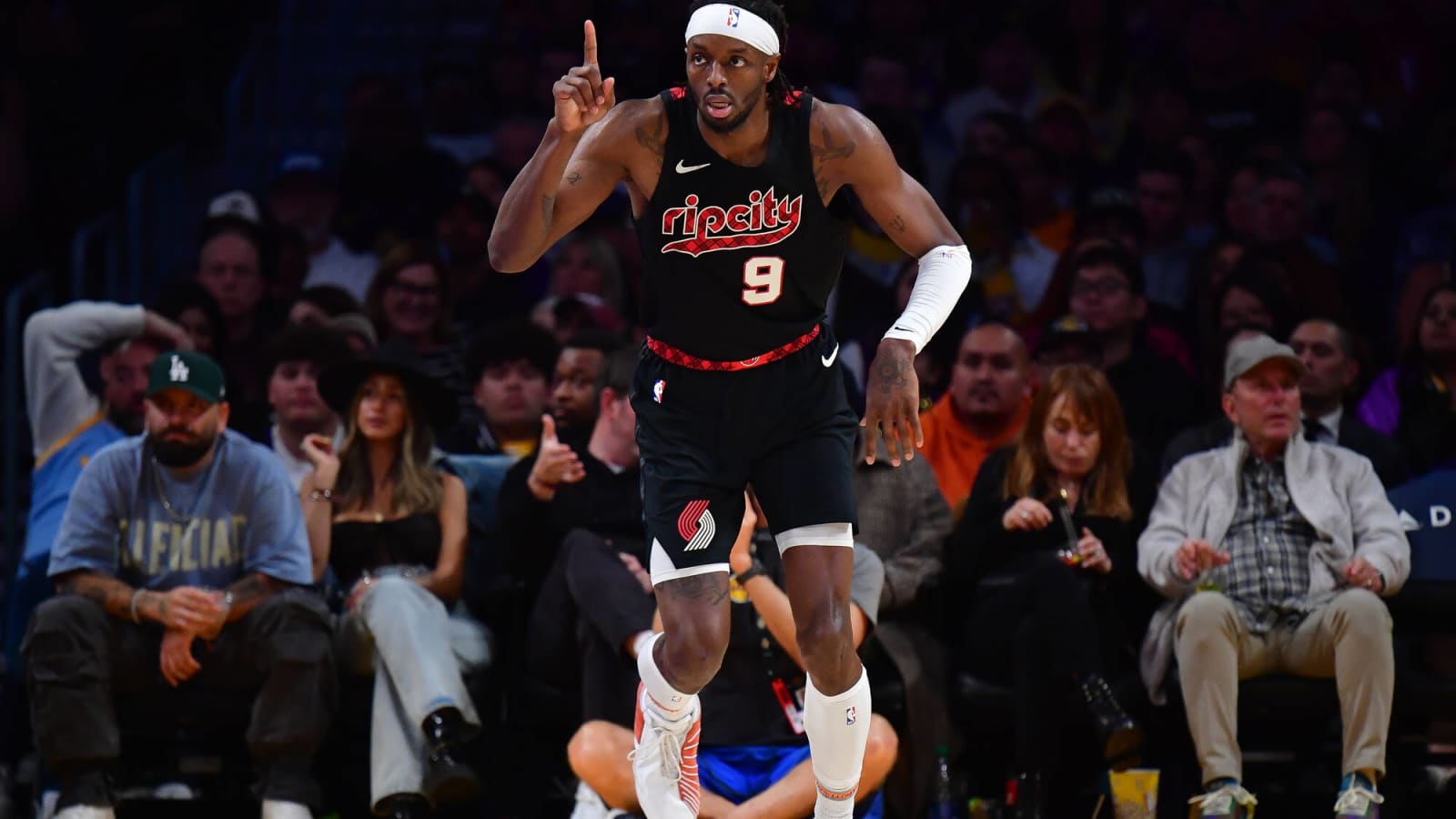
On January 17, 2024, the Portland Trail Blazers made good on a whirlwind, come-from-behind victory against the Brooklyn Nets.
While it was Anfernee Simons who floated like a butterfly and stung like a bee for the win, that master stroke would not have been without the preceding offensive possession. A double-team forced the ball from Simons’ hands and into the path of Malcolm Brogdon with little time left on the clock. With nothing doing but to shoot the ball, Brogdon pressed send for a three point dagger.
The leather rattled in-and-out and caromed above the basket. Toumani Camara, sensing his moment, ran for the glass, caught it and threw it back in for a dunk attempt. That attempt met back iron and soared right into the hands of Jerami Grant, equally soaring, equally crashing. But ever so gently flicking the ball through the net.
The play would put the Blazers up 103-101, notched points 29 and 30 for Grant, and seemed the dagger but for a moment. Portland has long dreamed of a player that could perform such feats of sport. Not since the days of LaMarcus Aldridge have they boasted such a presence of talent in the forward spot.
And yet, for some reason, a large portion of fans, observers and media figures have suggested that Jerami Grant must go. Yesterday, preferably. Today, posthaste.
Poppycock. Claptrap. Malarkey. Bunkum and balderdash. Tripe and twaddle and all manner of Victorian disdain that one can think on this topic.
Phooey.
The Blazers are a better team with Grant, than without him. And to trade him now is to misunderstand the dynamics of rebuilding. While the purpose of any rebuilding team is to lose games, the goal is to lose them competitively. To allow for younger players to make their bones in the tight moments and learn what not to do when the score is tighter than horsehair on a violin bow.
Hence the purpose of this article: the value of Jerami Grant.
It’s a topic that can be explored via statistics pulled from Cleaning the Glass and in-game clips. It will examine his strengths, weaknesses and the terms of his contract. By the end it will showcase the value of such a caliber player brings to a poor team such as the Portland Trail Blazers.
Strengths
Total Offense
Jerami Grant is a certified bucket. He’s averaging 21.7 points per game, making a ridiculous amount of long mid-range shots (46%). The advanced stats
| 52.5 Effective FG% (eFG%) |
Points/shot attempt (PSA) | Shooting Fouled % (SFLD%) | FT% |
|---|---|---|---|
| 52.5 eFG% | 116.3 | 12.7% | 80.3% |
| 49th percentile | 53rd percentile | 73rd percentile | 62nd percentile |
Despite field goal discrepancies, Grant has proven he can handle the ball and make a shot in a jam or find ways to the free throw line. He’s above average in PSA at 116.3 and solid in drawing fouls with 12.7% of all shots resulting in a trip to the line where he makes an acceptable rate of 80.3%.
| Total Offense | Rim Field Goals | Mid-Range Field Goals | Three-Point Field Goals |
|---|---|---|---|
| 52.5 eFG% | 59.8% (104/174) | 40.2% (95/236) | 40.3% (81/201) |
| 49th percentile | 32nd percentile | 39th percentile | 75th percentile |
| 58 ASTD% | 40 ASTD% | 39 ASTD% | 97 ASTD% |
| 87th percentile | 96th percentile | 83rd percentile | 49th percentile |
For all of those reasonable figures, Grant still plays even better off-the-ball. Represented in the rate of assisted shots taken (ASTD%), he takes the majority of his shots off actions initiated by his teammates. Once can see where he plays off-ball and on-ball. His three point attempts are almost entirely derivative of a swing or kickout action, while his midrange and rim attempts are a result of driving and post actions.
A key thing to remember is that the assisted rate improves in percentile as the raw percentage goes down, an indication that the player is an offense unto themselves. But lower assisted rates are still representative of generally poor team offense. The Blazers currently average 22.2 assists per game, worst in the league.
As a team, they are not equipped to win games without Grant at least taking the offense into his hands for 5-10 possessions and scoring a generally consistent 20 points per game. The only wins when Grant played and scored less than 20 points came against Sacramento Kings and Cleveland Cavaliers squads. Both teams were blindsided by breakout games from Portland’s youth and reserves, but for now, that remains the exception.
Three Point Shooting
There’s no other way around it, this is Grant’s best three-point shooting season. As Lamar Hurd describes that potent shot, it’s all chip and no dip. If the ball comes to him too low, he can shoot it, he has shot it and he has made it often enough. He will more likely put in on the floor or send it back.
| All Three | Corner Three | Non-Corner |
|---|---|---|
| 40.3% (81/201) | 41.9% (31/74) | 39.3% (50/127) |
| 75th percentile | 71st percentile | 68th percentile |
However, when his teammates place that ball high and in his hands? It’s an automatic three points. This buoys his mediocre field goal rates at the rim (60%, 32nd percentile among all forwards) and short mid range (37%, 32nd percentile).
Without Grant, the Blazers transform from a poor shooting team into an abysmal shooting team. Without Grant, the opponents sag off their assignments to stop the Blazers’ backcourt from penetrating and finding their shot. Without Grant, double teams and zones are not only a norm, but a credible defense.
Passing
Grant is also a much better passer than advertised or given credit. He’s just not a willing passer. His 12.6% assist rate (74th percentile), compared to his usage rate (24.7%) actually creates a mediocre assist to usage ratio: 0.51 (36th percentile). This lends credence to a “black hole” reputation when the ball comes to him.
| Usage Rate | AST% (Assist Rate) | Assist:Usage Ratio |
|---|---|---|
| Usage Rate | AST% (Assist Rate) | Assist:Usage Ratio |
| 25.1% | 12.4% | 0.50 |
| 87th percentile | 72nd percentile | 37th percentile |
And yet, this can be posited as an unfortunate symptom of unrefined talent.
Grant will pass when he has someone to pass to. Unfortunately, his options are limited due to subpar shooting from the team at-large and a lack of continuity. The Blazers shoot 50.3 eFG% as a team and have featured 21 different starting lineups for the year. Despite those limited options, there are still moments of brilliance to be found in Grant’s passing game.
The choice to pass does affect winning; the Blazers record when he accrues four-plus assists per game tallies at 3-5 (.375) and 7-19 (.269) when he stays at three or below. You could explain this away due to a poverty of talent or that the offense is designed with him as a play finisher in mind.
Regardless, the assist rate reinforces the simple truth: when his younger teammates play well and make their shots, Grant can pass to them more comfortably, accrue more assists and win more ball games.
Weaknesses
Rebounding
Rebounding is Jerami Grant’s greatest weakness. There is no perhaps or mayhap about this. Grant can not, will not and shall not rebound if he doesn’t have to. He will box out on a free throw, he will grab the loose ball if it bounces in his direction and he will take the ball coast-to-coast if the opportunity arises.
|
fgOR% (Off Rebounds/FG) |
fgDR% (Def Rebounds/FG) |
ftOR% (Off Rebounds/FT) |
ftDR% (Def Rebounds/FT) |
|---|---|---|---|
| 2.0% | 8.9% | 0.0% | 7.8% |
| 16th percentile | 17th percentile | 0th percentile | 25th percentile |
Nevertheless, there is no hunger to go out there and move bodies for a board. It’s a major reason why head coach Chauncey Billups has started either Camara or Walker in the supporting forward spot. Their skillsets are entirely complimentary to each other and Grant. Furthermore, if you’re trading Grant to any team, it’s most likely not because of his rebounding.
Passive Defense
To be clear, this does not mean Grant is a bad overall defender. He’s actually quite a solid defender who has been burned by the lack of talent on his teams. He’s already tasked as a point of attack defender against the likes of Kevin Durant and Kawhi Leonard. He often plays low within the 2-3 zone defense that the Blazers use to little effect.
A pressing issue (among many) with the Blazers’ defense is an inability to cut off the corner three spot after the offense creates “the chase.” It’s not just opposing offenses that create a chase; because the younger Blazers are encouraged to poke, prod and play the passing lanes, their defense creates situations where those youthful teammates take off before the ball is secured, leaving wide open gaps.
Grant does not play those gaps, he’s not patrolling the passing lanes and he is not looking for steals. He will pocket the odd bad pass or shot here or there, as he averages just under a steal per game. Instead Grant’s value comes through as a solid bet to face-up, move his feet and contest without fouling, potentially ending in a block.
The numbers ultimately suggest he’s a starter on a bad defensive team. The eye test suggests that coaches have figured out how to adjust to Billups’ desire to press high and hard. The results leave Grant out to dry.
Intangibles
Fills a Position of Need
This one comes without the statistics. But even as the Blazers no longer contend or pretend for a playoff spot, Grant fills a position of need. During the Lillard-era, the Blazers were always searching for the holotype wing-forward that could make three-pointers, attack closeouts and play adequate defense. After years of suffering a drought of talent in both forward positions, fans could be forgiven to look at Grant as a unicorn of sorts.
He’s the sole reason the Blazers’ frontcourt does not founder in total disarray. He offers unique small-ball lineups opportunities where Jabari Walker, Toumani Camara and Shaedon Sharpe can crash the glass and cover for his poor rebounding. In these lineups he can either play off-ball or spot some point-forward minutes.
And even as the Blazers have started to prospect that archetype with players like Walker, Camara and Kris Murray, none of them have games as polished as Grant. Until the stable makes some serious progress, the Blazers are stuck with an above-average wing-forward playing the second option even if he operates better as a third or fourth option. The horror, for some, the stark reality for most.
Until the Blazers find talent that requires or encourages they move Grant, they are quite satisfied plugging the lineup with his services.
The Locker Room Gauge
By all accounts, Grant represents the temperament of the lock room. He is essential to the chemistry according to reporters Danny Marang and Sean Highkin. That’s an important factor to consider during a tough season. The Portland Trail Blazers are a team of absolutely no continuity beyond a year. They still suffer patchwork rotations and have an ever-crowded guard rotation.
Without Grant on the floor, the Blazers are prone to run super-small lineups. It’s a lineup that see Walker or Camara playing the center position. They hardly need to become smaller, and blowout losses to Phoenix, Dallas, Oklahoma and Minnesota prove that they already do not have enough size or talent.
So if they can tank and rebuild just fine with him, why jeopardize a locker room without him?
The Contract
Ultimately, general managers trade contracts, not players. And Grant’s is a solid one. His future years are not horrendous for the level of production that he gives. The valuation doesn’t rise above $30M until 2025-26, when the cap is also expected to spike. From year two, his salary actually reaches the apex of its cap share. Past that year, he’s a solid piece to find draft picks and expiring contracts that can carve out space for future big money contracts.
| Year | 1 | 2 | 3 | 4 | 5 |
| Season | 2023-2024 | 2024-2025 | 2025-2026 | 2026-2027 | 2027-2028 |
| Age | 29 | 30 | 31 | 32 | 33 |
| Salary | $27,586,207 | $29,793,104 | $32,000,001 | $34,206,898 | $36,413,790 |
| % of Cap | 20.28% | 20.98% | 20.49% | 19.91% | 19.27% |
The only point that changes might come in year four at age 32 when production usually slows down for most NBA players. But if the Blazers have held on to him at that point, it’s probably because they see value in keeping him on as the elder statesman. Even if they were to trade him in year five, his expiring contract would be attractive enough to warrant picks.
So, What Is the Value of Jerami Grant?
To be clear: no one has the slightest clue as to how much Cronin values Grant. He’s said nothing official beyond the basic platitudes. Grant, for his part, has stated no desire to be moved, as reported by Highkin. On the surface, the Blazers are happy to have him and have no desire to move him. Fans might desire differently, but it’s a position that often overlooks the strengths and harps on the weaknesses.
There’s value in waiting for the cap landscape to shift and transform a solid third-fourth option wing-forward with ball handling skills into even more valuable commodity than he is already. There’s value in just letting him stay and continue his role as a wily veteran who has seen it all. There’s also value in trading him late as an expiring contract. Portland has the luxury to wait and see and time the market as they so desire.
If they do trade him this year or the next, it’s because they see an opportunity to either acquire his immediate successor or promote from within the locker room. Jabari Walker is a candidate that comes to mind. However, Walker’s game is inconsistent and still in need of refinement. Make this move prematurely and the Blazers incur chaos in the locker room for little reason. The Blazers don’t need to do this, Cronin does not need to do this and Billups probably prefers the front office not do this.
So, if you’re a playoff team in desire of a certain wing-forward who can shoot the lights out, put the ball on the floor and act as point of attack defense, then prepare to put up an offer Portland cannot refuse.
Anything less and they walk from the table.
More must-reads:
- Cavaliers make major move regarding president Koby Altman
- Three takeaways from the first weekend of NBA Summer League
- The 'Most points in a game by NBA team in 2024-25' quiz
Breaking News
Trending News
Customize Your Newsletter
 +
+
Get the latest news and rumors, customized to your favorite sports and teams. Emailed daily. Always free!
